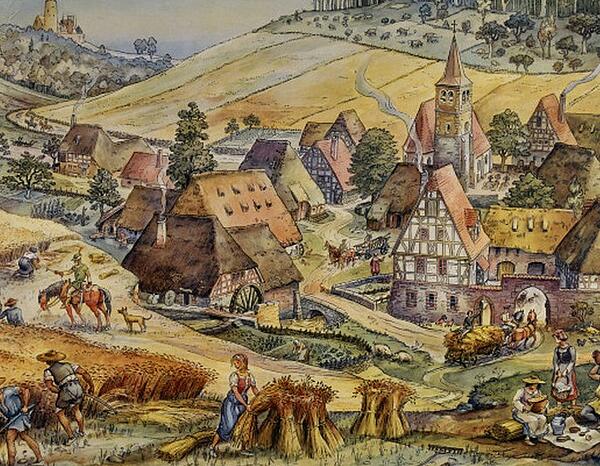Medieval Farming Calendar
The Medieval farming calendar was dictated by the weather, with peasant farmers having to take on specific duties and specific times to ensure the crops would grow.
The following table provides details of a typical farming calendar, charting the farming work that was completed each month and the type of weather the farmer would be looking for.

| Month | Work that needed to be done | Weather the farmer wanted |
|---|---|---|
| January | Mending and making tools, repairing fences | Showers |
| February | Carting manure and marl | Showers |
| March | Ploughing and spreading manure | Dry, no severe frosts |
| April | Spring sowing of seeds, harrowing | Showers and sunshine |
| May | Digging ditches, first ploughing of fallow fields | Showers and sunshine |
| June | Haymaking, second ploughing of fallow field, sheep-shearing | Dry weather |
| July | Haymaking, sheep-shearing, weeding of crops | Dry early, showers later |
| August | Harvesting | Warm, dry weather |
| September | Threshing, ploughing and pruning fruit trees | Showers |
| October | Last ploughing of the year | Dry, no severe frosts |
| November | Collecting acorns for pigs | Showers and sunshine |
| December | Mending and making tools, killing animals | Showers and sunshine |
The second table provides explanations for some of the terms commonly used by farmers in Medieval England.
| Marl | This lime-like clay was often used in Medieval times as manure. |
|---|---|
| Frosts | Medieval peasants were incredibly concerned about frosts as a single instance had the potential to kill a peasant’s crop. Frosts could cause irreparable damage to seeds, leaving families or whole villages without any crops for a whole year. |
| Harrowing | This was a spiked farming tool which covered seeds after they were planted, just like a garden rake. |
| Fallow Fields | Fallow fields were portions of land left to themselves for a year so they could repair themselves and provide stronger soil for years to come. Unfortunately, if a field was used repeatedly it would lose its fertility and fail to produce crops. |
| Acorns | Originating from oak trees, acorns were commonly used for feeding pigs in Medieval times. The pigs, which would roam local forests, would then grow larger, providing more meat for the lords. |
| Heavy Rain | Rain was a huge concern for farmers during the summer. At this point in the year the crop would almost be ready to harvest, but a serious rain storm could flatten the crops and make harvesting almost impossible. |
See also: Medieval Farming
MLA Citation/Reference
"Medieval Farming Calendar". HistoryLearning.com. 2026. Web.
